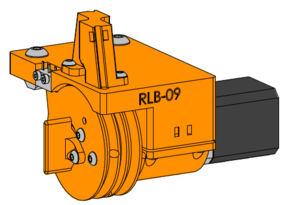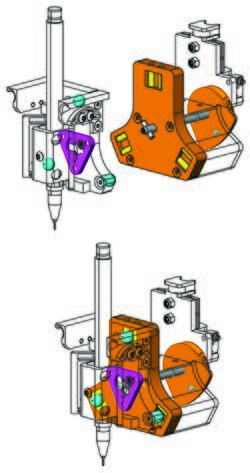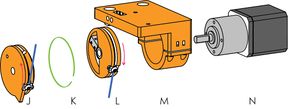The Remote Elastic Lock
The Remote Elastic Lock (REL) is the subsystem responsible for locking and releasing a tool on the carriage. While the kinematic coupling features on both carriage and tool do te work of locating tools to a consistent position, the REL locks it into place.
Tool Pickup Behavior
Properly locking a tool into the coupling at all 6 points of contact requires a nesting force a force applied that pushes the tool balls and carriage pins together. This nesting force is applied with the twist lock, which rotates into the wedge plate. As the twist lock rotates, the helical feature in the wedge plate creates both an axial and radial force applied from the shaft to the tool. The radial force is due to friction and should be minimized while the axial force is responsible for holding the tool in place. This process, when cycled thousands of times, will eventually wear out the wedge plate from the repeated rubbing, which will need to be replaced.
Detecting Locked/Unlocked Tools
When a tool is picked up, the twist lock rotates into the carriage to a specified setpoint at which point the tool is considered locked. This setpoint is not position-based, however, but torque-based. That is, only when a particular torque value is applied to the twist lock is a tool considered fully engaged. There are key advantages to a torque based locking system. First, the system is less susceptible to wear-and-tear. As the machine cycles through thousands of lock/unlock movements, either the twist lock pin or the wedge plate can eventually wear out. With a torque-based locking setup, tools will continue to lock consistently throughout the life time of the parts, rather than gradually degrading in reliability. Second, this setup makes Jubilee more ready to accommodate slight changes in geometry on the wedge plate feature. Even if wedge plates differ slightly from manufacturing processes, they will likely still work. One extension of this concept is that wedge plates can, in principle, be 3D printed. However, this is not recommended as the "stair-step" feature of the printing process can cause the twist lock to snag and twist the tool, rather than apply a majority axial force that pulls it into the locking position.
Actuating the Twist Lock Remotely
The twist-lock is actuated by a stationary motor driving two flexible mechanical control cables controlling a pulley. These control cables are sheathed in an extension spring called spring guide, allowing them to freely follow the carriage. These control cables work similarly to a bicycle brake cable. Pulling one control cable rotates the twist-lock into the wedge, causing it to lock the tool. Pulling the other cable releases the twist-lock from the wedge, in turn, releasing the tool. These two cable ends are attached to a motor that sits stationary on the frame. With remote control cables, we can move the actuating motor off of the carriage, reducing the weight of the carriage which increases the weight budget for tools.
Rotating the motor in either extreme triggers a limit switch to detect locked/unlocked tools. However, while one limit switch is stationary, the other floats on a free-wheeling pulley that is coupled through an extension spring to another pulley fixed to the shaft. This setup forms a series-elastic actuator, a robotics inspired setup for detection torque. In a tool locking procedure, the twist lock rotates into the wedge plate until it "gets stuck," putting the cable in tension. As the motor continues to rotate, this tension increases and the extension spring begins to stretch. Eventually, the spring stretches sufficiently that it triggers another limit switch set at a particular location in series in the motor's range of motion once the spring has been stretched. Since an ideal spring's force is proportional to it's stretch, and this force is applied over a moment arm around the pulley, this translates to a fixed torque value, at which point a tool is considered locked.


